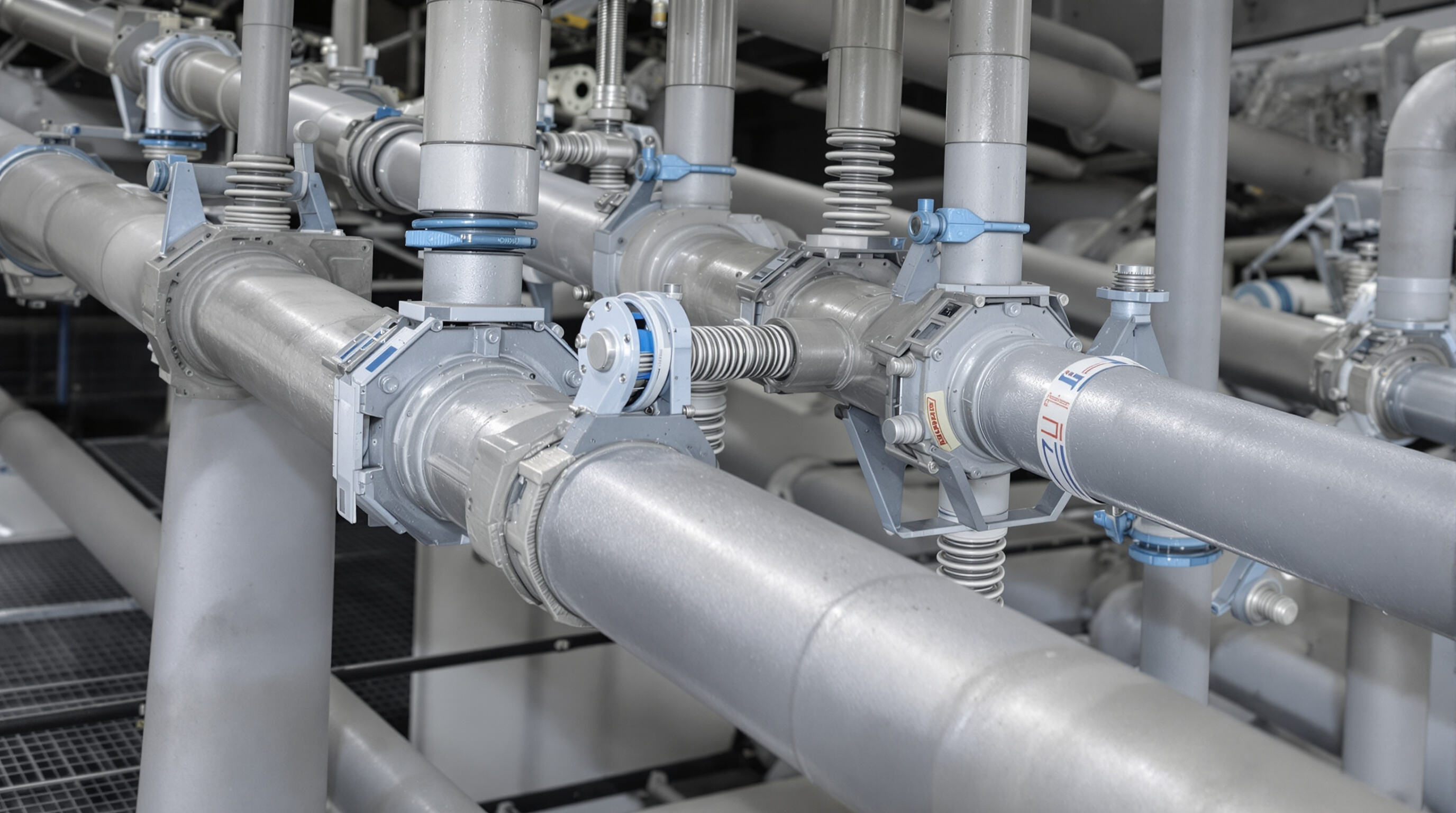ทำความเข้าใจเกี่ยวกับท่อปรับระดับได้และข้อได้เปรียบในการใช้งาน
ท่อปรับระดับได้คืออะไร และทำงานอย่างไร?
ตัวยึดท่อแบบปรับระดับได้ทำหน้าที่เป็นชิ้นส่วนพิเศษที่ใช้ยึดท่อไว้ในที่ของมัน แต่ยังอนุญาตให้ท่อเคลื่อนที่ขึ้นลง หรือซ้ายขวาเล็กน้อยเมื่อจำเป็น โดยปกติแล้วตัวยึดเหล่านี้จะมีลักษณะเหมือนฐานรับน้ำหนักที่แข็งแรง (ซึ่งเรียกว่าฐานรองรับน้ำหนัก) วางอยู่ด้านบนของส่วนที่สามารถปรับระดับได้ โดยปรับด้วยมือหรือด้วยเครื่องจักรบางชนิด เมื่อวิศวกรต้องการปรับระดับความสูงให้แม่นยำ พวกเขาจะทำการหมุนสลักเกลียวหรือปรับแหวนล็อกจนกว่าทุกอย่างจะเข้าที่เข้าทาง ซึ่งช่วยแก้ปัญหาเช่น การขยายตัวของท่อเมื่อได้รับความร้อน การสั่นสะเทือน หรือการติดตั้งที่อาจคลาดเคลื่อนจากระดับที่กำหนด รายงานจากฝ่ายระบบการท่อในปี 2023 ระบุว่าตัวยึดท่อแบบปรับระดับรุ่นใหม่สามารถรับน้ำหนักได้มากถึง 15,000 ปอนด์ โดยยังคงการจัดระดับไว้ได้ดี ความคลาดเคลื่อนไม่เกินหนึ่งในสิบของนิ้ว
หน้าที่หลัก: การกระจายแรง, การจัดแนว, และความมั่นคงของระบบ
หน้าที่หลักสามประการที่กำหนดคุณสมบัติของตัวยึดท่อแบบปรับระดับได้ ได้แก่
- การกระจายภาระ : ถ่ายโอนแรงน้ำหนักจากท่อไปยังฐานโครงสร้าง ลดจุดความเครียดเฉพาะที่ลงได้ถึง 40% เมื่อเทียบกับระบบแบบแข็ง (ข้อมูลความสอดคล้องตามมาตรฐาน ASME B31.3)
- การควบคุมการจัดแนว : รักษาตำแหน่งท่อให้อยู่ในช่วง ±0.5° ตามข้อกำหนดการออกแบบในระหว่างกระบวนการเปลี่ยนแปลงอุณหภูมิ
- การรับประกันความมั่นคง : ลดการสั่นแบบฮาร์มอนิกในระบบที่มีอัตราการไหลสูง (ความเร็วของของเหลว 15 ฟุต/วินาที) โดยใช้กลไกการยึดด้วยแรงเสียดทาน
ชุดค่าผสมนี้ช่วยป้องกันความล้มเหลวต่างๆ เช่น การรั่วของหน้าแปลน หรือการแตกหักของตัวยึด โดยเฉพาะในระบบที่มีการเปลี่ยนแปลงอุณหภูมิสูงกว่า 200°F
การเปรียบเทียบกับตัวยึดแบบแข็งและแบบตายตัว
ต่างจากการยึดแบบเชื่อมหรือยึดด้วยสลักเกลียวแบบแข็ง ตัวยึดแบบปรับได้มีความสามารถในการตอบสนองต่อสภาพการใช้งานที่เปลี่ยนแปลง ความแตกต่างที่สำคัญ ได้แก่
| สาเหตุ | ตัวยึดแบบปรับได้ | ตัวยึดแบบแข็ง |
|---|---|---|
| การชดเชยอุณหภูมิ | การปรับระดับแนวตั้ง ±2" | ตำแหน่งคงที่ |
| ความเร็วในการติดตั้ง | เร็วขึ้น 30% (แบบโมดูลาร์) | ต้องการการเชื่อม/ขัด |
| การเข้าถึงการบํารุงรักษา | มองเห็นได้รอบวงจร | พื้นผิวที่ถูกบดบัง |
การศึกษาเชิงอุตสาหกรรมปี 2023 พบว่า สถานประกอบการที่ใช้ตัวยึดท่อแบบปรับระดับได้ สามารถลดต้นทุนการแก้ไขงานท่อลงได้ 28,000 ดอลลาร์ต่อโครงการ เมื่อเทียบกับตัวยึดแบบคงที่ ความสามารถในการปรับเทียบใหม่ในระหว่างการทดสอบระบบหรือหลังเกิดเหตุการณ์แผ่นดินไหว ทำให้ตัวยึดเหล่านี้มีความสำคัญต่อโรงงานกระบวนการสมัยใหม่
มาตรฐานการออกแบบและการจัดประเภทของตัวยึดท่อแบบปรับระดับได้
ตัวยึดท่อแบบปรับระดับได้ถูกออกแบบมาเพื่อตอบสนองความต้องการในอุตสาหกรรมอย่างเข้มงวด โดยมีความยืดหยุ่นควบคู่ไปกับความแข็งแรงของโครงสร้าง มาตรฐานสากลช่วยให้มั่นใจได้ว่าสามารถใช้งานร่วมกันได้ในระบบท่อที่หลากหลาย และแก้ปัญหาเฉพาะทางในแต่ละภาคส่วน
การจัดประเภทตามโครงสร้าง: ประเภทของตัวแขวนและตัวยึดแบบปรับระดับได้
การใช้งานในอุตสาหกรรมส่วนใหญ่ใช้สามประเภทหลัก:
- ตัวแขวนที่ปรับระดับได้ สำหรับการจัดการแรงบรรทุกในแนวตั้ง
- ตัวยึดแบบเลื่อนได้ เพื่อรับมือกับการเคลื่อนที่ด้านข้างจากอุณหภูมิ
- ตัวยึดสปริงแบบปรับค่าได้ สำหรับการเคลื่อนที่ในแนวตั้งแบบควบคุมได้
ระบุเหล่านี้สามารถปรับระดับความสูงได้ทั่วไป ±25 มม. ระหว่างการติดตั้งและการใช้งาน ซึ่งให้ประสิทธิภาพเหนือกว่าตัวยึดแบบแข็งในสภาพแวดล้อมที่เปลี่ยนแปลงได้
พารามิเตอร์การออกแบบสำคัญสำหรับการใช้งานอุตสาหกรรม
วิศวกรให้ความสำคัญกับ 6 ปัจจัยเมื่อกำหนดตัวยึดท่อแบบปรับระดับได้
- อุณหภูมิการใช้งานสูงสุด (ช่วง -50°C ถึง 800°C)
- สัมประสิทธิ์การขยายตัวจากความร้อนของวัสดุท่อ
- แรงบรรทุกสถิตย์รวม (น้ำหนักท่อ + ฉนวน + สารที่บรรทุก)
- แรงจากแรงกระแทกของของเหลวหรือกิจกรรมแผ่นดินไหว
- ศักยภาพการกัดกร่อนของสภาพแวดล้อมในการทำงาน
- ความถี่ของการเข้าถึงเพื่อการบำรุงรักษาที่ต้องการ
ความสอดคล้องตามมาตรฐาน ASME สำหรับระบบรองรับที่ปรับได้
รหัสของสถาบันวิศวกรเครื่องกลแห่งอเมริกา (ASME) B31.1 และ B31.3 กำหนดไว้ว่า:
- ต้องมีตัวเลขความปลอดภัยอย่างน้อย 2:1 สำหรับแรงดึงที่จุดคราก (Yield Strength)
- การทดสอบอายุการใช้งานภายใต้แรงกระทำซ้ำๆ (Fatigue Life Testing) สำหรับการใช้งานที่มีแรงโหลดเปลี่ยนแปลงเป็นรอบๆ
- การรับรองคุณภาพวัสดุสำหรับโลหะผสมที่ใช้งานที่อุณหภูมิสูง
- การรับรองขั้นตอนการเชื่อมตาม ASME Section IX
การปฏิบัติตามมาตรฐานเหล่านี้ช่วยลดข้อผิดพลาดในการติดตั้งลง 34% เมื่อเทียบกับระบบไม่ผ่านมาตรฐาน (วารสารระบบสายส่ง 2023)
โซลูชันวิศวกรรมสำหรับโครงการในภาคพลังงานที่ต้องการความแม่นยำสูง
โรงงานนิวเคลียร์และโรงงานแอลเอ็นจีต้องการตัวยึดที่มีคุณสมบัติ:
- สามารถปรับระดับละเอียดได้ในระดับไมครอน
- ความสามารถในการยึดต้านการสั่นสะเทือน (รองรับแรงสั่นสะเทือนได้สูงสุดที่ระดับ 0.6g ของการเร่งตัวของพื้นดิน)
- วัสดุที่ทนต่อรังสี (เคลือบด้วย Hastelloy หรือ Inconel)
- อายุการใช้งานออกแบบมาให้ใช้งานได้ 50 ปีในสภาพแวดล้อมพื้นที่ชายฝั่งทะเล
การติดตั้งล่าสุดบนแท่นขุดเจาะนอกชายฝั่งได้แสดงให้เห็นว่าสามารถชดเชยการขยายตัวจากความร้อนได้เร็วกว่าการติดตั้งแบบยึดตายที่ปรับปรุงใหม่ถึง 22%
การจัดการการขยายตัวจากความร้อนและแรงกระทำแบบไดนามิกผ่านความสามารถในการปรับตั้งค่า

การรับมือกับแรงกระทำสถิตและไดนามิกของท่อ (น้ำหนัก ของไหล อุณหภูมิ)
ตัวยึดท่อที่สามารถปรับตั้งค่าได้นั้น รับแรงกระทำสถิตและไดนามิกได้ค่อนข้างดีในสภาพแวดล้อมอุตสาหกรรม แรงกระทำสถิต ได้แก่ น้ำหนักจริงของท่อเองรวมถึงของไหลที่ท่อต้องบรรทุกอยู่ตลอดทั้งวัน ซึ่งจำเป็นต้องมีการยึดแนวตั้งที่แข็งแรงและไม่ยวบยวนมากนัก ส่วนแรงกระทำไดนามิกเกิดขึ้นจากความเปลี่ยนแปลงของอุณหภูมิในระยะยาว ดังนั้นระบบจึงต้องมีพื้นที่ให้ท่อเคลื่อนที่ได้โดยไม่เกิดการแตกหัก การออกแบบตัวยึดที่ดีจะช่วยกระจายแรงกระทำไปทั่วเครือข่ายท่อทั้งหมด แทนที่จะปล่อยให้จุดใดจุดหนึ่งต้องรับแรงทั้งหมด ซึ่งจะช่วยป้องกันปัญหาการเสียหายเฉพาะจุดที่ไม่มีใครต้องการยกตัวอย่างเช่น ตัวแขวนสปริงที่ปรับตั้งค่าได้ ซึ่งช่วยรักษาความสมดุลของระบบแม้จะเกิดการเปลี่ยนแปลงของแรงกระทำถึง 20 ถึง 30 เปอร์เซ็นต์ ซึ่งเป็นเรื่องปกติในระบบไอน้ำตามโรงงานต่างๆ
ความท้าทายจากแรงขยายตัวจากความร้อนและความยืดหยุ่นของตัวยึดที่ปรับตั้งค่าได้
การขยายตัวจากความร้อนสามารถทำให้ท่อขยายตัว 1.5–2 นิ้ว ต่อระยะ 100 ฟุต ในช่วงการเปลี่ยนแปลงอุณหภูมิสูงถึง 650°F (343°C) ตามที่ระบุไว้ใน วารสารวิศวกรรมความร้อนเพื่อการปรับปรุงประสิทธิภาพ การรองรับแบบปรับได้สามารถแก้ปัญหาดังกล่าวได้ผ่าน:
- ช่วงการเคลื่อนที่ที่ควบคุมได้ (0.5–3 นิ้ว) ที่เหมาะสมกับค่าสัมประสิทธิ์การขยายตัวเฉพาะของวัสดุ
- ความแข็งแกร่งที่ปรับเปลี่ยนได้ โครงสร้างที่ช่วยสร้างสมดุลระหว่างความยืดหยุ่นและความสามารถในการรับน้ำหนัก
- การปรับระดับได้หลายแกน เพื่อจัดการรูปแบบการเคลื่อนที่เชิงสามมิติที่ซับซ้อน
กลไกที่ปรับตั้งได้ในพื้นที่เพื่อควบคุมการเคลื่อนที่จากความร้อน
การปรับแต่งหลังการติดตั้งช่วยให้ผู้ใช้งานสามารถ:
- ชดเชยการทรุดตัวหรือการจัดแนวอุปกรณ์ที่ผิดเพี้ยน
- ปรับเทียบฐานรองใหม่หลังจากอุณหภูมิกระบวนการเปลี่ยนแปลง
- เพิ่มประสิทธิภาพในการกระจายแรงโหลดในระหว่างการอัปเกรดระบบ
การปรับแกนเกลียวที่มีขั้นตอนความละเอียด 1/4 นิ้ว ช่วยให้ปรับตำแหน่งระดับมิลลิเมตรได้โดยไม่ต้องใช้เครื่องมือพิเศษ
การปรับสมดุลระหว่างความสามารถในการปรับตั้งได้กับความคาดการณ์เชิงโครงสร้าง
ฐานรองแบบปรับตั้งได้รุ่นใหม่สามารถรักษาความแปรปรวนของกำลังรับน้ำหนักไว้ที่ระดับ <5% ตลอดช่วงการปรับตั้งทั้งหมด เพื่อให้มั่นใจได้ถึง:
- การกระจายแรงเครียดอย่างคาดการณ์ได้ภายใต้เหตุการณ์แผ่นดินไหว
- ความถี่การสั่นพ้องที่คงที่ (±2 เฮิรตซ์) ในช่วงที่มีการไหลปะทุ
- ประสิทธิภาพที่สม่ำเสมอตลอดช่วงการบำรุงรักษา
ความแม่นยำนี้ทำให้เหมาะสำหรับการใช้งานที่สำคัญ เช่น ท่อบายพาสกังหันและวงจรของเหลวหล่อเย็นปฏิกิริยา
ความทนทานต่อสิ่งแวดล้อมและความแข็งแกร่งในการดำเนินงานของตัวยึด
อายุการใช้งานของวัสดุภายใต้สภาพแวดล้อมที่รุนแรง
ตัวยึดท่อที่สามารถปรับได้ถูกออกแบบมาให้มีอายุการใช้งานยาวนานแม้จะต้องเผชิญกับสภาพแวดล้อมที่รุนแรง เช่น การกัดกร่อน ความร้อนสูง และความชื้นสูง โดยทั่วไปผู้คนนิยมใช้เหล็กกล้าไร้สนิมหรือโลหะเคลือบสังกะสีแบบจุ่มร้อน เนื่องจากวัสดุเหล่านี้ทนสนิมได้ดี งานวิจัยบางส่วนในปี 2025 แสดงให้เห็นว่าท่อที่เคลือบด้วยอีพ็อกซี่มีอายุการใช้งานยาวนานขึ้นประมาณ 40 เปอร์เซ็นต์ก่อนจะเริ่มเห็นสัญญาณการสึกหรอเมื่อจมอยู่ในน้ำเค็ม สำหรับพื้นที่ใกล้ชายฝั่งทะเลหรือกลางทะเล ผู้ผลิตเริ่มหันมาใช้คอมโพสิตพลาสติกขั้นสูงมากขึ้น วัสดุเหล่านี้สามารถทนต่อความเสียหายจากแสงแดดและสารเคมีได้ดีกว่า ซึ่งเป็นปัจจัยสำคัญสำหรับอุปกรณ์ที่ติดตั้งในพื้นที่ชายฝั่งที่สภาพแวดล้อมท้าทายนี้
ประสิทธิภาพภายใต้ภาระบางครั้ง: สภาวะแผ่นดินไหว ลมแรง และการทดสอบด้วยน้ำ
โครงสร้างรองรับที่เรากำลังพูดถึงนี้สามารถรับมือกับสถานการณ์ที่เกิดความเครียดขึ้นโดยไม่คาดคิด ด้วยเส้นทางการรับน้ำหนักที่ออกแบบไว้หลายช่องทางร่วมกับวิศวกรรมความยืดหยุ่นที่ชาญฉลาด เมื่อเกิดแผ่นดินไหว ระบบเหล่านี้จะอนุญาตให้เกิดการเคลื่อนที่ไปมาในแนวนอนแบบควบคุมได้ ในขณะที่ยังคงความสามารถในการรับน้ำหนักในแนวตั้งไว้ได้ ซึ่งช่วยลดการสึกหรอของท่อราว 60 เปอร์เซ็นต์ เมื่อเทียบกับระบบที่ใช้แบบดั้งเดิมที่มีความแข็งแรงยิ่ง ข้อได้เปรียบดังกล่าวแสดงให้เห็นอย่างชัดเจนจากการศึกษาของเราในโครงการลมนอกชายฝั่ง สำหรับวัตถุประสงค์ในการทดสอบด้วยไฮโดร ช่วงการปรับตั้งถูกปรับเทียบค่าไว้ล่วงหน้าแล้ว จึงสามารถรับแรงดันได้มากกว่าปกติประมาณสองถึงสามเท่า โดยไม่เกิดความเสียหายถาวร และที่น่าสนใจไปกว่านั้น ปัจจุบันการคำนวณแรงลมได้เริ่มคำนึงถึงการปรับตัวแบบเรียลไทม์เหล่านี้แล้ว ซึ่งหมายความว่าวิศวกรสามารถปรับความแข็งแกร่งของระบบได้แบบไดนามิกตามสภาพแวดล้อมที่เปลี่ยนแปลงไปตลอดทั้งวัน
ประสิทธิภาพในการติดตั้งและการประยุกต์ใช้งานจริงของตัวรองรับที่ปรับตั้งค่าได้

การลดงานแก้ไขซ้ำด้วยระบบรองรับท่อแบบปรับตั้งในพื้นที่
ท่อแบบรองรับที่ปรับตั้งได้ช่วยลดข้อผิดพลาดในการติดตั้ง เนื่องจากช่วยให้คนงานสามารถปรับเปลี่ยนความสูงและการจัดแนวขณะทำงานในพื้นที่จริงได้ ตามรายงานจากคู่มือโซลูชันการติดตั้งของนิตยสาร Solar Builder ระบุว่า โครงการที่ใช้ระบบปรับตั้งได้เหล่านี้สามารถประหยัดเวลาแรงงานได้ประมาณร้อยละ 36 เมื่อเทียบกับตัวเลือกแบบติดตายในรูปแบบเดิม ด้วยเหตุผลที่ไม่จำเป็นต้องเชื่อมด้วยการเชื่อมแบบอาร์กอนในระหว่างการติดตั้ง ความยืดหยุ่นแบบนี้มีความสำคัญอย่างมากในสถานที่เช่น โรงกลั่นและโรงงานแปรรูปเคมีภัณฑ์ ที่ซึ่งท่อจะเกิดการขยายตัวและหดตัวเนื่องจากอุณหภูมิเปลี่ยนแปลง บางครั้งการขยายตัวอาจเกินกว่าสองนิ้วทั้งด้านบวกและลบ ซึ่งทำให้ตัวรองรับแบบติดตายมีปัญหาหากไม่มีความสามารถในการปรับตัวในตัว
แนวทางปฏิบัติที่ดีที่สุดสำหรับการติดตั้งและการจัดแนวในระบบที่ซับซ้อน
การสำรวจด้วยเลเซอร์และการใช้เครื่องมือจัดแนวแบบโมดูลาร์ก่อนการติดตั้ง ช่วยลดการเยื้องศูนย์ของท่อในชั้นวางอุตสาหกรรมแบบหลายระดับได้ถึง 40% (รายงานอุตสาหกรรม, 2566) แนวทางปฏิบัติที่ดีที่สุด ได้แก่:
- ตรวจสอบน้ำหนักบรรทุก : การทดสอบความจุของโครงยึดที่ ±15% มากกว่าขีดจำกัดการออกแบบ
- ยึดยืนแบบค่อยเป็นค่อยไป : การยึดโครงสร้างหลักก่อนการติดตั้งส่วนประกอบรอง
- การติดตามในเวลาจริง : การใช้เกจวัดแรงดึงเพื่อยืนยันการกระจายแรงบรรทุกในระหว่างการทดสอบระบบ
กรณีศึกษา: การใช้โครงยึดปรับระดับได้ในโครงการปรับปรุงโรงกลั่นน้ำมัน
โรงกลั่นน้ำมันแห่งหนึ่งบนชายฝั่งอ่าวเม็กซิโกสามารถลดความล่าช้าในการทดสอบระบบลงได้ 30% ในช่วงปรับปรุงปี 2022 โดยการเปลี่ยนโครงยึดแบบตายตัว 58 ชุด เป็นแบบปรับระดับได้ ระบบนี้รองรับท่อส่งน้ำมันดิบขนาด 18 นิ้ว ที่ต้องเผชิญกับการเปลี่ยนแปลงอุณหภูมิแบบรอบที่ 160°F โดยไม่ต้องปรับโครงยึดเพิ่มเติมเลยตลอด 12 เดือนของการดำเนินงาน
แนวโน้มที่เพิ่มขึ้นในการใช้ระบบปรับระดับได้แบบโมดูลาร์และแบบผลิตสำเร็จรูป
ปัจจุบันตัวยึดปรับระดับสำเร็จรูปมีสัดส่วนถึง 28% ของการติดตั้งอุตสาหกรรมใหม่ ๆ ซึ่งได้รับแรงผลักดันจากการผสานการทำงานเข้ากับกระบวนการทำงานก่อสร้างที่ขับเคลื่อนด้วย BIM (การวิเคราะห์ตลาด ปี 2023) ระบบนี้ให้ประโยชน์ดังต่อไปนี้:
- หลีกเลี่ยงการชนกัน : การผสานแบบจำลอง 3 มิติ ช่วยลดข้อผิดพลาดในการประสานงานหน้างานลง 22%
- ความสอดคล้องตามมาตรฐาน ASME : ค่ารับน้ำหนักที่รับรองจากโรงงานช่วยให้กระบวนการตรวจสอบมีความคล่องตัวมากยิ่งขึ้น
- ความสามารถในการปรับขนาด : ตัวต่อแบบยึดด้วยโบลท์ช่วยให้สามารถขยายท่อโดยไม่ต้องเปลี่ยนชุดฐาน
คำถามที่พบบ่อย (FAQs) เกี่ยวกับตัวยึดท่อปรับระดับได้
ตัวยึดท่อปรับระดับได้คืออะไร?
ตัวยึดท่อปรับระดับได้คืออุปกรณ์ที่ใช้สำหรับยึดท่อให้อยู่ในตำแหน่งที่กำหนด ขณะเดียวกันก็อนุญาตให้มีการเคลื่อนที่แบบควบคุมได้เพื่อรองรับการขยายตัว การสั่นสะเทือน และการไม่ตรงแนว ตัวอุปกรณ์โดยทั่วไปมีฐานรับน้ำหนักและกลไกปรับระดับสำหรับการตั้งค่าความสูงและตำแหน่ง
เหตุใดตัวยึดท่อปรับระดับได้จึงเป็นที่นิยมมากกว่ายึดแบบตายตัว?
ตัวยึดแบบปรับระดับได้มอบการตอบสนองที่มีประสิทธิภาพต่อสภาพแวดล้อมที่เปลี่ยนแปลง มีการติดตั้งที่รวดเร็วขึ้น ให้การเข้าถึงที่ดีขึ้นเพื่อการบำรุงรักษา และสามารถปรับเทียบค่าใหม่ได้ในระหว่างเหตุการณ์ เช่น การทดสอบระบบหรือกิจกรรมที่เกี่ยวข้องกับแผ่นดินไหว
ตัวยึดปรับระดับจัดการกับการขยายตัวจากความร้อนอย่างไร
ตัวยึดจัดการกับการขยายตัวจากความร้อนโดยอนุญาตให้มีช่วงการเคลื่อนที่ที่ควบคุมได้ และสามารถปรับระดับได้หลายแกน ซึ่งช่วยจัดการรูปแบบการเคลื่อนที่เชิงซับซ้อน โดยไม่กระทบต่อความสมบูรณ์ของโครงสร้างระบบท่อ
วัสดุที่ใช้สำหรับตัวยึดท่อแบบปรับระดับมีอะไรบ้าง
วัสดุที่ใช้กันอย่างแพร่หลาย ได้แก่ สแตนเลสและโลหะเคลือบสังกะสีแบบจุ่มร้อน เนื่องจากมีความต้านทานการกัดกร่อน นอกจากนี้ยังมีการใช้วัสดุคอมโพสิตพลาสติกขั้นสูงที่มีความทนทานในสภาพแวดล้อมที่รุนแรง
ตัวยึดแบบปรับระดับช่วยเพิ่มประสิทธิภาพในการติดตั้งอย่างไร
การสนับสนุนเหล่านี้ช่วยลดข้อผิดพลาดในการติดตั้งและเวลาแรงงาน เนื่องจากสามารถปรับตั้ง onsite ได้โดยไม่ต้องเชื่อมโลหะ ทำให้ปรับใช้ได้ดีในสภาพแวดล้อมที่มีการเคลื่อนที่เนื่องจากอุณหภูมิเปลี่ยนแปลงอย่างมาก
สารบัญ
- ทำความเข้าใจเกี่ยวกับท่อปรับระดับได้และข้อได้เปรียบในการใช้งาน
- มาตรฐานการออกแบบและการจัดประเภทของตัวยึดท่อแบบปรับระดับได้
- การจัดการการขยายตัวจากความร้อนและแรงกระทำแบบไดนามิกผ่านความสามารถในการปรับตั้งค่า
- ความทนทานต่อสิ่งแวดล้อมและความแข็งแกร่งในการดำเนินงานของตัวยึด
- ประสิทธิภาพในการติดตั้งและการประยุกต์ใช้งานจริงของตัวรองรับที่ปรับตั้งค่าได้
- คำถามที่พบบ่อย (FAQs) เกี่ยวกับตัวยึดท่อปรับระดับได้

